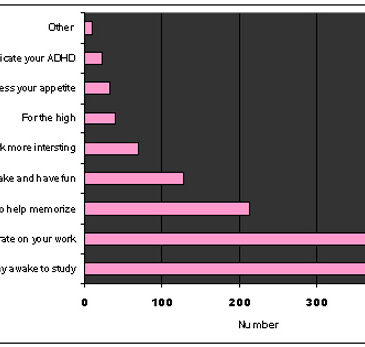The increasing frequency of Attention Deficit Hyperactivity Disorder (ADHD) diagnoses (Center for Disease Control, 2005; Robinson, Sclar, Skaer, & Galin, 1999)) has created an opportunity for an increasing rate of illicit use of the drugs used to treat this disorder. But, compared to other drugs of abuse, the ingestion of ADHD drugs might occur for some atypical reasons. This week’s BASIS reviews DeSantis et al.’s research about undergraduates’ illicit use of ADHD medication. According to researchers, students use the medication illicitly not with the intent of achieving a “high” or “having fun”; instead, they intend to “study longer, stay focused without distractions, and be more productive” at school (DeSantis, Webb, & Noar, 2008).
Participants
- Researchers used a convenience sample of undergraduate students enrolled in a large public university in the southeast US.
- A total of 1, 811 students completed the surveys.
Data Collection
- Researchers used both a quantitative survey instrument and qualitative in-person interviews with a subsample of participants to obtain information about students’ ADHD medication use.
Instrument
- The survey included questions related to demographics, students’ awareness of other students’ stimulant use, the details, perceptions, and reasons for use, and other drug and alcohol use
Results
- 4% (N=78) of the sample had legal prescriptions for ADHD medication.
- Of the 1, 811 undergraduates, 34% (N=585) reported having used ADHD medication illegally during their lifetime.
- Figure 1 shows that among this 34% the top three self-reported reasons for using illicit ADHD medication were related to academic objectives.

Figure. Reasons for Illegal Use of ADHD Medication (N=585). Click image to enlarge.
Limitations
- Theses results are limited by the use of self-reported data from only one university.
- The use of this convenience sample means that results might not generalize to a broader population.
Conclusions
According to DeSantis et al., the use of ADHD medication at this particular university was stigma free and students (39%, N=231) found it “very easy” to obtain pills from people on campus. The ease with which students could obtain drugs and the lack of stigma suggest that conventional methods of dealing with substance use and addiction might not be successful in treating students who abuse ADHD medication. The reasons for use (i.e. to do better, to get good grades, perceived increased intelligence and cognitive aptitude) are difficult to argue against in today’s society and seem distinct from stereotypical reasons for drug use (i.e, to escape, to have fun, to get high, peer pressure). To prevent the illicit use of prescription ADHD medication, dosages should be closely monitored to limit the extra pills that students have and pass on to friends. School and prevention programs would also benefit from changing their courses to include information about the physiological dangers of abusing prescription medication.
What do you think? Please use the comment link below to provide feedback on this article.
References
Center for Disease Control. (2005). Mental health in the United States. Prevalence of diagnosis and medication treatment for attention-deficit/hyperactivity disorder–United States, 2003. Morbidity and Mortality Weekly Report, 54(34), 842-847.
DeSantis, A. D., Webb, E. M., & Noar, S. M. (2008). Illicit use of prescription ADHD medications on a college campus: a multimethodological approach. J Am Coll Health, 57(3), 315-324.
Robinson, L., Sclar, D., Skaer, T., & Galin, R. (1999). National trends in the prevalence of attention-deficit/hyperactivity disorder and the prescribing of methylphenidate among school-age children; 1990-1995. Clinical Pediatrics, 38(4), 209-217.




